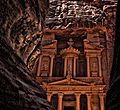Al-Khazneh facts for kids
Al-Khazneh (which means "The Treasury" in Arabic) is one of the most amazing buildings in Petra. Petra is an ancient city that was once the capital of the Nabataean Kingdom. The Nabataeans were an ancient Arab people. Like many other buildings in Petra, Al-Khazneh was carved right into a sandstone rock face.
People believe Al-Khazneh was built as a tomb for the Nabataean King Aretas IV Philopatris. This was around the 1st century AD. Today, it is one of the most popular places for tourists to visit in Jordan. It got its name "The Treasury" in the early 1800s. Local Bedouin people thought it held hidden treasures.
Contents
History of Al-Khazneh
Al-Khazneh was first built as a tomb and burial place. This happened at the start of the 1st century AD, during the time of King Aretas IV Philopatris. Its Arabic name, Treasury, comes from an old story. The story says that bandits or pirates hid their treasure in a stone pot (called an urn) high up on the second level.
You can actually see bullet marks on this urn. Local stories say that Bedouins shot at the urn in the early 1900s. They hoped to break it open and find the treasure. But the urn is actually solid sandstone and just for decoration! Another story says it was the treasury of an Egyptian Pharaoh during the time of Moses.
Many of the building's details have worn away over the past two thousand years. This is because it was carved directly from the cliff. The sculptures on the building are thought to be figures from old myths. They are linked to the afterlife. At the very top, there are four eagle figures. People believed these eagles would carry souls away. On the upper level, you can see dancing Amazons holding double-axes. The main entrance has statues of the twin gods Castor and Pollux. These gods were said to live partly on Mount Olympus and partly in the Greek underworld.
How Tourism Affects Al-Khazneh
In 1812, a Swiss explorer named Johann Ludwig Burckhardt rediscovered the city of Petra and Al-Khazneh. As more people from Western Europe explored the Middle East, tourism grew. By the 1920s, a small hotel even opened near Petra.
Petra was not as famous as bigger cities like Cairo. But tourism still began to change the lives of the Bedouin people living nearby. Today, tourism is the main way people in Jordan earn money. Hotels, souvenir shops, restaurants, and horse rentals are all found close to Petra. While tourism has helped the economy, the site itself faces challenges from so many visitors.
The moisture from large groups of people can harm the dry sandstone. White spots have appeared on the walls and columns. This is from a substance called stearic acid, which comes from hands touching the walls. The surface of Al-Khazneh has worn away by about 40 millimeters in less than ten years. This is due to people touching, leaning, or rubbing against its walls.
Al-Khazneh in Popular Culture
The Treasury has been in many Hollywood movies. It became very famous after being shown in the popular 1989 film Indiana Jones and the Last Crusade. In the movie, its front is shown as the entrance to the final resting place of the Holy Grail. The inside scenes of the temple were filmed in England at Elstree Studios.
The TV series Ancient Megastructures: Petra from National Geographic Channel is all about Al-Khazneh. It explains how this amazing structure was built using human cleverness and hard work.
Images for kids
See also
 In Spanish: Tesoro de Petra para niños
In Spanish: Tesoro de Petra para niños







